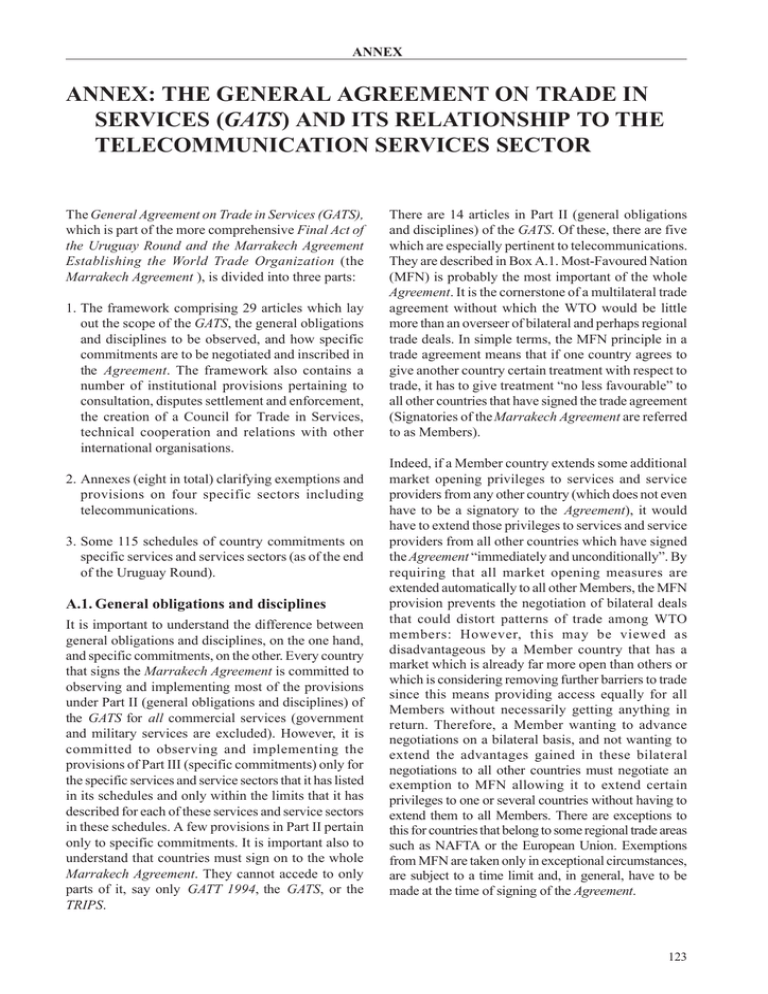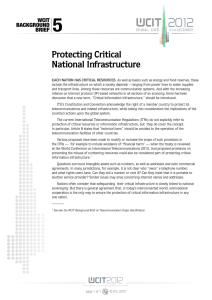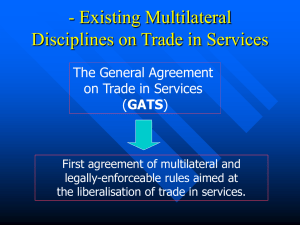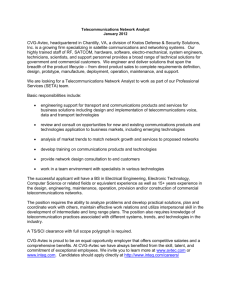ANNEX: THE GENERAL AGREEMENT ON TRADE IN GATS TELECOMMUNICATION SERVICES SECTOR
advertisement

ANNEX ANNEX: THE GENERAL AGREEMENT ON TRADE IN SERVICES (GATS) AND ITS RELATIONSHIP TO THE TELECOMMUNICATION SERVICES SECTOR The General Agreement on Trade in Services (GATS), which is part of the more comprehensive Final Act of the Uruguay Round and the Marrakech Agreement Establishing the World Trade Organization (the Marrakech Agreement ), is divided into three parts: 1. The framework comprising 29 articles which lay out the scope of the GATS, the general obligations and disciplines to be observed, and how specific commitments are to be negotiated and inscribed in the Agreement. The framework also contains a number of institutional provisions pertaining to consultation, disputes settlement and enforcement, the creation of a Council for Trade in Services, technical cooperation and relations with other international organisations. 2. Annexes (eight in total) clarifying exemptions and provisions on four specific sectors including telecommunications. 3. Some 115 schedules of country commitments on specific services and services sectors (as of the end of the Uruguay Round). A.1. General obligations and disciplines It is important to understand the difference between general obligations and disciplines, on the one hand, and specific commitments, on the other. Every country that signs the Marrakech Agreement is committed to observing and implementing most of the provisions under Part II (general obligations and disciplines) of the GATS for all commercial services (government and military services are excluded). However, it is committed to observing and implementing the provisions of Part III (specific commitments) only for the specific services and service sectors that it has listed in its schedules and only within the limits that it has described for each of these services and service sectors in these schedules. A few provisions in Part II pertain only to specific commitments. It is important also to understand that countries must sign on to the whole Marrakech Agreement. They cannot accede to only parts of it, say only GATT 1994, the GATS, or the TRIPS. There are 14 articles in Part II (general obligations and disciplines) of the GATS. Of these, there are five which are especially pertinent to telecommunications. They are described in Box A.1. Most-Favoured Nation (MFN) is probably the most important of the whole Agreement. It is the cornerstone of a multilateral trade agreement without which the WTO would be little more than an overseer of bilateral and perhaps regional trade deals. In simple terms, the MFN principle in a trade agreement means that if one country agrees to give another country certain treatment with respect to trade, it has to give treatment “no less favourable” to all other countries that have signed the trade agreement (Signatories of the Marrakech Agreement are referred to as Members). Indeed, if a Member country extends some additional market opening privileges to services and service providers from any other country (which does not even have to be a signatory to the Agreement), it would have to extend those privileges to services and service providers from all other countries which have signed the Agreement “immediately and unconditionally”. By requiring that all market opening measures are extended automatically to all other Members, the MFN provision prevents the negotiation of bilateral deals that could distort patterns of trade among WTO members: However, this may be viewed as disadvantageous by a Member country that has a market which is already far more open than others or which is considering removing further barriers to trade since this means providing access equally for all Members without necessarily getting anything in return. Therefore, a Member wanting to advance negotiations on a bilateral basis, and not wanting to extend the advantages gained in these bilateral negotiations to all other countries must negotiate an exemption to MFN allowing it to extend certain privileges to one or several countries without having to extend them to all Members. There are exceptions to this for countries that belong to some regional trade areas such as NAFTA or the European Union. Exemptions from MFN are taken only in exceptional circumstances, are subject to a time limit and, in general, have to be made at the time of signing of the Agreement. 123 WORLD TELECOMMUNICATION DEVELOPMENT REPORT Box A.1: The most important general obligations and disciplines with respect to telecommunications Most Favoured Nation (Article II). This most basic principle of a multilateral trade agreement requires that services and service suppliers of any WTO Member receive treatment which is “no less favourable” than the treatment accorded to like services and service suppliers of any other WTO Member. This means for example that the service suppliers of one Member should not be given better conditions to connect to the basic network or to access spectrum than service suppliers of all other Members. Exemptions to MFN can be listed in a separate schedule known as the Member’s List of Article II Exemptions. Transparency (Article III) requires that WTO Members publish all measures (i.e. laws, regulations, administrative guidelines, procedures, decisions, directives) which can affect the trade in services covered by a Member’s GATS commitments. The transparency provision also requires Members to inform the WTO of any new measures or changes to existing ones and to respond promptly to requests by other Members for specific information. Enquiry points are to be established for this purpose. The transparency provision does not require the publication of commercially confidential information. It is a key element in promoting the stability and predictability of the trading system because it allows service suppliers to know the rules under which they can do business in the country that has opened its markets. Domestic Regulation (Article VI) The provisions in this article are intended to ensure that a Member who has undertaken certain market opening commitments does not “nullify or impair such specific commitments” through measures relating to qualification requirements and procedures, technical standards, and licensing requirements. The provisions of this article require, furthermore, that the WTO develop disciplines to ensure that any such requirements, if they exist, are based on objective and transparent criteria and are not more burdensome than necessary to ensure the quality of the service. This is referred to as the “Article VI Work Programme” which will be put into effect now that the basic telecommunications negotiations have been completed. Monopolies and Exclusive Service Providers (Article VIII) Nothing within the GATS prevents a Member from maintaining monopolies so long as these are not contrary to its specific commitments; however, this article requires that Members ensure that such monopolies do not act in a manner which is inconsistent with the Member’s MFN obligations and specific commitments. Furthermore, the Member should ensure that the monopoly does not abuse its monopoly position by, for example, subsidising its competitive activities (which may be provided by an affiliate) with the profits of its monopoly activities. This provision is repeated in the NGBT’s regulatory framework Reference Paper. Business Practices (Article IV). Similar to Article VIII, this article deals with certain business practices of service suppliers which may restrain competition and thereby restrict trade in services. Like Article VII, it is relevant because of the prevalence of monopolies and exclusive service providers in this sector and, where competition has been introduced, the frequent presence of telecommunications service providers with a dominant market share and the potential to gain unfair advantage from their position. Source: General Agreement on Trade in Services (GATS). A.2. Specific commitments and schedules reduce the level of access inscribed in their schedules. As stated, specific commitments apply only to the services and service sectors listed in each country’s schedule. These contain each Member’s commitments on market access, national treatment, and possible additional commitments (see Box A.2). In the schedules, Members may grant full market access and national treatment or they may enter any limitations, conditions, and qualifications that they will maintain on these two provisions. The schedules may also indicate the time frame for implementation of a country’s commitments. Whether full or limited access is granted, signatories may not take measures that Limitations to market access and national treatment serve also as a starting point for subsequent negotiations towards greater liberalization. National treatment (Article XVII) is defined as treatment of foreign services or service suppliers that is no less favourable than that granted to domestic services or suppliers. 124 A country schedule has four columns. The first allows the country to list the sector or sub-sector in which it is making a specific commitment. In the second, it lists the limitations that it wishes to impose on market ANNEX Box A.2: Specific Commitments Provisions of the General Agreement on Trade in Services Market Access (Article XVI) is the country’s commitment to open its market to permit service providers from other Member countries to sell the listed telecommunication services in a manner consistent with any limitations that have been indicated. Market access limitations are defined primarily in terms of quantitative restrictions, but also include some other forms of limitations such as caps on foreign equity participation or restrictions or requirements regarding the type of legal entity permitted to supply the service. National Treatment (Article XVII) requires that Member countries subject foreign telecommunication providers to conditions no more onerous than the conditions imposed on domestic providers, except with respect to any departures from national treatment explicitly stated as limitations in its offer (e.g., some governments have entered restrictions on the ability of foreigners to purchase land or have indicated in schedules that foreign equity participation in a service supplier in a particular sector is limited to a certain, specified percentage). There may be limitations on nationality or residency of directors, foreign ownership restrictions, or preferences given to domestic suppliers in the allotment of frequencies. Additional Commitments (Article XVIII) create an open-ended possibility to negotiate and agree on commitments on measures affecting trade in services, that are not expressly captured by market access and national treatment. Source: General Agreement on Trade in Services (GATS). access and similarly in the third column, the limitation pertaining to national treatment. These limitations are stated in terms of the four modes of delivery of a service which are recognized in the GATS, namely, 1) from the territory of one Member into the territory of any other Member (cross-border supply); 2) in the territory of one Member to the service consumer of any other Member (consumption abroad); 3) by a service supplier of one Member, through commercial presence in the territory of any other Member (commercial presence); 4) by a service supplier of one Member, through presence of natural persons of a Member in the territory of any other Member (presence of natural persons). Examples taken from the telecommunications sector for each of these four modes of delivery are given in Table A.1. Additional commitments are listed in the fourth column. These may be with respect to interconnection, anti-competitive safeguards, licensing, type approval, numbering and other procedures, pricing related measures, rights of way, etc. A sample schedule is shown in Table A.2. Even though some 54 of 125 countries have not yet made any specific commitment on telecommunications services at the conclusion of the GBT negotiations, they are nevertheless committed to respecting the general obligations and disciplines contained in Part II of the GATS and the Annexes (including: MFN, transparency, and domestic regulation). They may, of course, sign on to the Agreement at any time. When they do, they become bound by the general obligations and by the commitments they make with respect to specific services and services sectors. It is important to distinguish between MFN exemptions and limitations. The latter are stated in the schedules and are used to qualify conditions of market access and national treatment. The former allows a Member country to extend certain privileges to one or several countries without having to extend them to all Members. A.3 Annex on Telecommunications The Annex on Telecommunications was developed to elaborate certain aspects of the GATS pertaining to this sector and, in particular, to recognize the dual role of telecommunications as a mode of delivery for other services and for goods as well as a tradable service in its own right. All services (not only telecommunications) listed in a Member’s schedule of commitments benefit from the rules governing access to and use of telecommunication networks and services which are elaborated in the Annex on Telecommunications. There are also annexes dealing with air transport, maritime transport and financial services; however, the Annex on Telecommunications is by far the most elaborate. 125 WORLD TELECOMMUNICATION DEVELOPMENT REPORT Table A.1: Modes of supply and examples for telecommunications Example Mode of supply 1) Cross-border supply Service supplier not present within the territory of the Member Service delivered within the territory of the Member, from the territory of another Member. International telecommunications is the most commonly scheduled form of crossborder supply in the sector. Under the traditional correspondent relationship an international operator in one country delivers traffic to a corresponding international operator in a destination country. Countries may enter limitations to prevent bypass of exclusive international operators. There are, however, other forms of cross-border supply in telecommunications such as Global Mobile Personal Communications Service (GMPCS) where the supplier is not necessarily present in the territory where the user of the service is presently situated. Also, telecommunications plays an important role in the crossborder supply of other services such as travel and tourism, air transport and data processing. In this respect the Telecommunications Annex, which ensures “access to and use of public telecommunications transport networks and services (including international) on reasonable and non-discriminatory terms and conditions” for all scheduled services, is important. Service delivered outside the territory of the Member, in the territory of another Member, to a service consumer of the Member. 2) Consumption abroad This mode of supply is often referred to as “movement of the consumer”. The essential feature of this mode is that the service is delivered outside the territory of the member making the commitment. Often the actual movement of the consumer is necessary but this mode also pertains to the movement of the property of a consumer across the border, for example, for a repair service provided in another country. One of the most common examples of consumption abroad in telecommunications is roaming of cellular mobile subscribers between countries which has been facilitated by standards such as Global System for Mobile (GSM) communications. Calling card and country-direct direct services are other forms of consumption abroad. They allow a subscriber to “consume” telecommunication services in the territory of another WTO Member. Countries have generally scheduled few restrictions on this mode of supply of telecommunications service. 3) Commercial presence 4) Presence of natural persons Service supplier present within the territory of the Member. Service delivered within the territory of the Member, through the commercial presence of the supplier. This mode covers not only the presence of juridical persons in the strict legal sense, but also that of legal entities which share some of the same characteristics. It includes, inter alia, corporations, joint ventures, partnerships, representative offices and branches. Service delivered within the territory of the Member, with the supplier present as a natural person. This mode covers natural persons who are themselves service suppliers, as well as natural persons who are employees of service suppliers. Here, the service supplier is not necessarily established in the country, but may send an employee or other person for a fixed period of time to provide the service. Consulting services provided by telephone companies and others are examples of this mode of supply in telecommunications. The most common form of commercial presence in the sector is through foreign direct investment (FDI), whereby foreign investors purchase part or all of a telecommunication operator or service provider in the country. Limitations may be stated in terms of the permitted legal form of commercial presence; a foreign equity ceiling; the percentage of board of directors that have to be nationals; restrictions on the number of licences to be granted; etc. Such foreign ownership restrictions are common in the telecommunications sector which was formerly dominated by state-owned monopolies. Most countries have entry restrictions on the movement of natural persons to supply a service which usually apply across the board to all services equally and therefore may have the entry, “…….as indicated in the horizontal section”. Source: ITU adapted from the General Agreement on Trade in Services (GATS). 126 ANNEX The purpose of the Annex is not to liberalize or to permit competition in telecommunications per se, as this is achieved by the listing of telecommunications in schedules and by recurring negotiations on the progressive liberalization of services trade. The Annex clearly indicates that it does not override limitations stipulated in a Member’s schedule (i.e., a provision stating that a Member is not required to authorise the supply of a service by a service supplier other than as provided for in its schedule of specific commitments). However, once a service has been scheduled, the Annex will guarantee the ability to make use of telecommunication networks and services to provide that service within and across borders. and use of the public telecommunication services needed to do business. The Telecommunications Annex is composed of seven sections, but its core obligations are contained in Section 5 on access to and use of public telecommunications. This section requires each Member to ensure that all service suppliers seeking to take advantage of scheduled commitments are accorded access to and use of public basic telecommunication networks and services on reasonable and non-discriminatory terms and conditions. Members incur these obligations irrespective of whether they have liberalized the supply of basic telecommunications or scheduled commitments in basic telecommunications. However, the beneficiaries of the disciplines in the Annex will be firms that supply services included in a Member’s schedule of commitments including not only telecommunication suppliers, but also suppliers of any service such as banking, computing, consulting, insurance, or travel and tourism. Suppliers of these services must be given the right to purchase or lease equipment, to interconnect, to use operating protocols of the supplier’s choice so long as no harm is caused to the network or misuse can be anticipated. These rights are subject to safeguards which can be permitted by the regulators, with the stipulation that such safeguards are not used to deny a customer access to The Annex also expands on how to apply the GATS transparency principle outlined in the Agreement (Article III) to the telecommunication sector. It calls for ensuring the public availability of all relevant information such as tariffs and licensing requirements. In other provisions, the Annex encourages technical co-operation between developed and developing countries with the goal of assisting developing countries in the advancement of the necessary infrastructure required to expand trade in services. It encourages Members to work toward this objective through the development programmes of international and regional organizations Developing countries are permitted to depart from the Annex obligations, if necessary, to impose reasonable conditions on the access to and use of public telecommunication networks that they consider necessary to strengthen their domestic telecommunication infrastructure and to increase their participation in international trade in telecommunication services. The Annex specifies that such departures must be listed in schedules. To date, no developing country has chosen to exercise this option. These Annex obligations strike a careful balance between the needs of service providers and users for fair terms of access, on the one hand, and the needs of the regulators and public telecommunication operators to maintain a system that works and that meets universal service objectives, on the other. The Telecommunications Annex borrows from basic principles established by the ITU, the OECD and other organizations. It is also reflects the long recognised need for competitive safeguards in an environment where monopoly and dominant telecommunications service providers could restrict access and use of their networks and facilities. 127 WORLD TELECOMMUNICATION DEVELOPMENT REPORT Table A.2: Sample schedule of a specific commitment (partial) for telecommunications under the General Agreement on Trade in Services (GATS) Modes of supply: 1) Cross-border supply; 2) Consumption abroad; 3) Commercial presence; 4) Presence of natural persons Sector or sub-sector Limitations on Market Access Limitations on National Treatment Additional Commitments 1) Until 31 December 2007 bypass of 1) None Additional commitments on regulatory disciplines. 2. COMMUNICATION SERVICES Telecommunication service a. d. e. f. g. Voice telephone services Telex services Telegraph services Facsimile Private leased circuit services exclusive operator(s) not permitted 2) None 3) Reserved to exclusive operator until 1 January 2000, at which time 3 licences will issued following a call-for-tender process to begin no later than 15 December 1998. The period of exclusivity for the three licence holders will end on 31 December 2007. There is a 49 per cent foreign ownership limit in the operator which has exclusivity until 1 January 2000 4) Unbound except as indicated in the horizontal section For public use b. Packet-switched data transmission services c. Circuit-switched data transmission services For non-public use (i.e. closed user groups): b. Packet-switched data transmission services c. Circuit-switched data transmission services Note: 2) None 3) Majority of the board of directors have to be nationals of the country 4) Unbound except as indicated in the horizontal section 1) Until 1 January 2000 bypass of exclusive operator not permitted 2) None 3) Reserved to exclusive operator until 1 January 2000. There is a 49 per cent foreign ownership limit in the operator which has exclusivity until 1 January 2000 4) Unbound except as indicated in the horizontal section 1) None 1) Until 1 January 2000 only on network facilities supplied by the exclusive operator and bypass of exclusive operator not permitted. 2) None 3) Until 1 January 2000 only on network facilities supplied by the exclusive operator and bypass of exclusive operator not permitted 4) Unbound except as indicated in the horizontal section 1) None 2) None 3) None 4) Unbound except as indicated in the horizontal section 2) None 3) None 4) Unbound except as indicated in the horizontal section The letters in column 1 relate to the classification system used in the WTO classification of telecommunication services for the purposes of making GATS commitments. The numbers in columns 2 and 3 relate to the modes of delivery. Unbound means that there is no commitment being made under a particular mode. In the example above, a monopoly is being maintained for voice telephone, telex, telegraph, facsimile, and private leased circuit services until 1 January 2000 after which three licences will be issued for these same services for which the market will be completely open after 1 January 2007. Circuit and packet switched transmission services for public use remain with the monopoly until 1 January 2000 after which time there will be no market entry restrictions. Private and closed user group circuit and packet switched data transmission networks are allowed but, until 1 January 2000, only over network facilities supplied by the monopoly. Until this date these private networks cannot be used to bypass the public data networks. Source: World Trade Organization. 128




